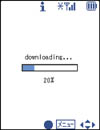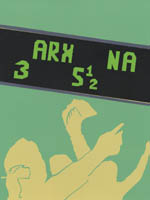The Pulse 1
Back to Contents of Issue: March 2004
|
|
|
|
|
|
|
MOBILE PAYMENTS ARE BELIEVED to be the next killer application for the mobile Internet. KDDI and DoCoMo began rolling out their new services at the start of this year, and both companies have been aggressively evaluating customer responses to their newest technologies to see how best to convey and receive cash.
In cooperation with large Japanese credit card companies -- JCB-VISA, Mitsui-Sumitomo Card, UC Card and Toyota Finance -- KDDI tested its technology over a period of five months late last year. Approximately 2,300 users received a Hitachi-made handset with a UIM-card (next generation SIM-card) with each individual's credit card information.
Two different methods were used for shopping. Through KDD's mobile portal EZweb, users could enter virtual shops to select and purchase goods. It was also possible for users to pay at the cashier's counter in conventional bricks and mortar shops. About 400 real shops and 23 virtuals participated.
For online shopping, the PKI (Public Key Infrastructure) method was applied to guarantee confidential transactions, authenticate the user and the shop, verify data integrity and authorize the transaction via digital signature.
The other method uses IR-communication to exchange credit card and user information between the phone and the cashier in a real shop. The user inputs a PIN code for accepting the transaction and the credit card details are sent to the cashier, who then contacts the credit card company for authorization.
During the 5-month trial, 2,300 participants made 1,900 mobile payments totalling JPY9 million. While the figures are far from stunning, those who made mobile payments in real shops did so more frequently and paid larger sums. CDs, DVDs, magazines and books were the most popular online shopping items, while most real shop payments were made in restaurants, food and fashion stores.
-- Arjen van Blokland
2004 Trend-Watchers Take Note
AS RECENTLY REPORTED AND published by the Telecommunications Carriers Association: The Japanese market added 500,000 new subscribers in December of last year, reaching a grand total of about 80 million mobile subscribers. The carriers that successfully introduced new services and devices posted the greatest gains.
KDDI topped the ranks for the third month in a row. In December, KDDI gobbled up 57 percent of the overall new subscribers, with 600,000 signing on as cdma-1X subscribers. Half of the KDDI customer base has now switched to cdma-1X phones, which offer super-fast multimedia downloads and GPS functionality. During the New Year's holidays, we observed legions of Tokyo day-trippers toting KDDI's latest Hitachi 3G handsets.
Vodafone was finally able to improve upon its relatively weak autumn 2003 performance. Due to its aggressive packet-fee discounts and sexy devices, Vodafone has the potential to grow by more than 100,000 subscribers. The company recently launched the Sharp V-601SH phone equipped with a 2 Megapixel camera. The camera is impressive, boasting autofocus and 20x zoom. Vodafone also got its first TV-handset in the market -- but we have yet to see many people showing it off.
Although DoCoMo's i-mode subscriber base fell slightly during a single week in December, it may still post growth for the full month. And i-mode seems set to have a stellar year in 2004.
FOMA is finally gaining momentum at the cost of its 2G subscriber base. There are almost 1.9 million FOMA subscribers now. The new FOMA subscribers from late 2003 must have felt a little disappointed when DoCoMo announced the new FOMA 900i-series.
Sharp, Panasonic, Mitsubishi, Fujitsu and NEC launched 900i devices in February. Surprisingly, Sony, Ericsson and Toshiba were not among the handset manufacturers mentioned by DoCoMo. The new phones can handle 500kB Java applications (a preview we saw of a J-League soccer game was very impressive). Production costs of this richer content are decreasing rapidly.
To satisfy content providers, DoCoMo had to raise the maximum subscription fee from JPY300 to JPY500. The i-menu on the phones can be browsed using Flash. Furthermore, DoCoMo will finally introduce chaku-uta (MP3 downloads) on its mainstream phones, and the text-based mail function will be extended with HTML, enabling mail-magazines to add richer contents.
-- Arjen van Blokland
JAPAN'S MINISTRY OF FINANCE has lost more than 70 billion dollars in the past financial year trying to bet against currency speculators. Cabinet Office insiders admitted in January that the currency losses have spiralled out of control, after a renewed attempt by the Finance Ministry to prop up the dollar and talk down the value of the yen.
The insiders told us that losses in a special ministry account that hold the government's intervention reserves are expected to soar to JPY7.8 trillion ($70 billion) by the end of the financial year.
The government spent a record sum in January trying to prevent the yen from rising too high against the dollar, a movement that would hurt Japan's all-important exporters -- on whose prosperity hopes of an economic recovery are pinned.
However, in mid-January Tokyo trading it was clear that Japanese exporters were also preventing the massive currency intervention program from succeeding. As the yen fell to 107.5, a number of carmakers were understood to be dumping large amounts of their foreign-earned dollars on the market.
When the ministry's huge losses are officially confirmed later this year, Junichiro Koizumi, the Prime Minister, will face pressure to prove that his controversial currency intervention strategy is working.
The battering to the ministry's foreign exchange account arises because the department is selling its own currency for dollars. As the value of the greenback continues to plunge, so too does the value of the dollars that the Japanese government has already purchased.
At the start of fiscal 2003, the ministry assumed an average exchange rate of JPY121 to the dollar. That was revised up to JPY115 by November.
In January, the figure jumped to just over JPY105.
The special account's paper losses will be realized once the ministry begins to unwind its huge holdings by selling dollars at these lower levels in exchange for yen. However, currency analysts we contacted suggested that the outlook for the dollar/yen exchange rate looks set to favor a continued slide in the greenback. This means that Japan is likely to continue accruing vast paper losses.
One currency broker in Nomura, the Japanese securities house, told us: "The (ministry) is like an intervention junkie at the moment. The effect of each shot of dollar buying is getting less and less, which means the shots have to be bigger and bigger. The odd shock move makes only a very temporary difference."
Japanese monetary authorities have effectively confirmed that the losses will not deter them from trying to swing the currency markets. So far this year, the Bank of Japan (BOJ) has bought an estimated $20 billion, and officials have assured markets that the intervention will continue.
In a surprise move, the BOJ eased monetary policy in what some economists said was an attempt to offset the failures of its intervention efforts. The central bank raised its liquidity target under its quantitative easing policy by JPY3 trillion to a new range of JPY30 trillion to JPY35 trillion, a margin that gives the BOJ scope to help the finance ministry's battle against the rising yen.
However, beyond that measure, analysts and BOJ sources have pointed out that Japan does not, in fact, have many policies to choose from beyond more costly intervention. The BOJ has virtually no scope for serious monetary easing, and Koizumi's structural reform program has tied the ministry's hands by piling on more fiscal spending.
-- The Editors
|
|
Note: The function "email this page" is currently not supported for this page.


 Killer Apps from DoCoMo and KDDI
Killer Apps from DoCoMo and KDDI
 Here's how it works: After selecting the product(s), the user selects his credit card company and sends the information to the shop. The user then accepts the transaction by entering a PIN code and a digital signature. Finally, the signed transaction is sent to the credit card company for payment authorization.
Here's how it works: After selecting the product(s), the user selects his credit card company and sends the information to the shop. The user then accepts the transaction by entering a PIN code and a digital signature. Finally, the signed transaction is sent to the credit card company for payment authorization.
 Intervention Junkies -- Addiction Without End?
Intervention Junkies -- Addiction Without End?



